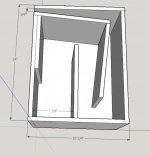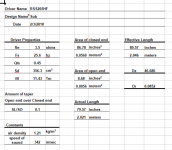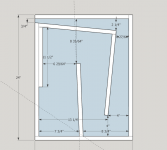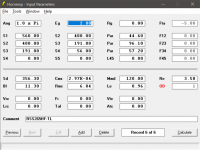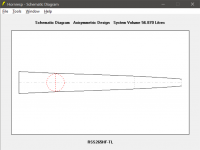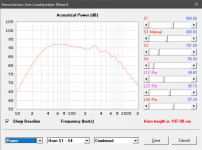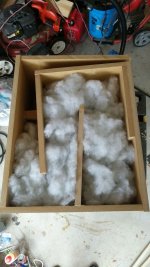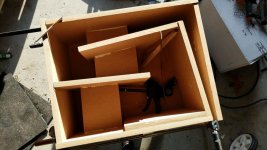Hello all,
Been lurking here for a while and searching and reading a lot. I have a space that is pretty much perfect for the size and shape of the old Fried Model H dual TL subwoofer. I am interested in music and transient response more than ultra-low bass, and I have good memories of the Fried from "back in the day".
Plans for Fried's original KEF-based enclosure are readily available but the drivers are long out of production. What current 8" drivers would be suitable for this application? Given a few suggestions, I'll start noodling with hornresp and other programs. I'd appreciate a starting point. One thought is this Tang Band driver, as it seems to at least somewhat mimic the original KEF B200-sp1022
Regards
Doug
Been lurking here for a while and searching and reading a lot. I have a space that is pretty much perfect for the size and shape of the old Fried Model H dual TL subwoofer. I am interested in music and transient response more than ultra-low bass, and I have good memories of the Fried from "back in the day".
Plans for Fried's original KEF-based enclosure are readily available but the drivers are long out of production. What current 8" drivers would be suitable for this application? Given a few suggestions, I'll start noodling with hornresp and other programs. I'd appreciate a starting point. One thought is this Tang Band driver, as it seems to at least somewhat mimic the original KEF B200-sp1022
Regards
Doug
Last edited:
The Fried H shape can be mimicked, but given the advances in TL-modeling one wants to start from scratch to create a line that is more optimal — or find an existing line that can be morphed into a Fried H shape.
Fried Model H
I have on a number of occasions done thot experiments to try to figure out how to get an optimal driver offset… end loaded maximally excites the harmonics, needing more damping to kill the ripple, which inevitably reduces the bass reinforcement. I have done an aperiodic line with a 50% offset that is praised by the fellow i loaned it to (and he wouldn’t give it back ) so that is a possibility.
) so that is a possibility.
dave
Fried Model H
I have on a number of occasions done thot experiments to try to figure out how to get an optimal driver offset… end loaded maximally excites the harmonics, needing more damping to kill the ripple, which inevitably reduces the bass reinforcement. I have done an aperiodic line with a 50% offset that is praised by the fellow i loaned it to (and he wouldn’t give it back
dave
50% offset seems quite difficult to construct in an enclosure with acceptable S.A.F. (spousal acceptance factor) One clear advantage of the Fried design is, despite is sheer size, its role as a speaker enclosure is easily disguised with a small amount of vibration-proof damping on top. The other thing that appeals is the opposing driver motions, which in theory should make it less susceptible to shaking and vibrations.
What drivers did you select for the design that wouldn't come home? Have you written about it somewhere? I'm eager to learn.
What drivers did you select for the design that wouldn't come home? Have you written about it somewhere? I'm eager to learn.
50% offset can be acheived simply by putting the driver on the other end. It does end up having the terminus at opposite ends, but at the frequencies involved bass is pretty much mono.
I have literally a 100+ TLs drawn in my CAD files, most of them ML-TLs. One could likely morph one of those into a shape that could be glued end to end (instead of side-by-side) to create the same kind of shape. If one doesn’t mind terminus at other end, and end-loads the line (not optimum) the construction becomes very easy.
This is for the Alpair12pw (a 6.5” driver) but the same kind of folding could be used for almost any ML-TL… this shape would need to be made wider and shallower, driver put on the top, then turned to the right orientation and another mirror imaged version attached to create the Fried shape. This design could also be doubled to use 2 drivers per side, and not have to make any significant changes. Our MTM with the unfolded version of this ML-TL provides quite satisfactory bass.
http://wodendesign.com/downloads/A12pw-folded-ml-tl-extents.pdf
I quickly sketched out what that would look like:
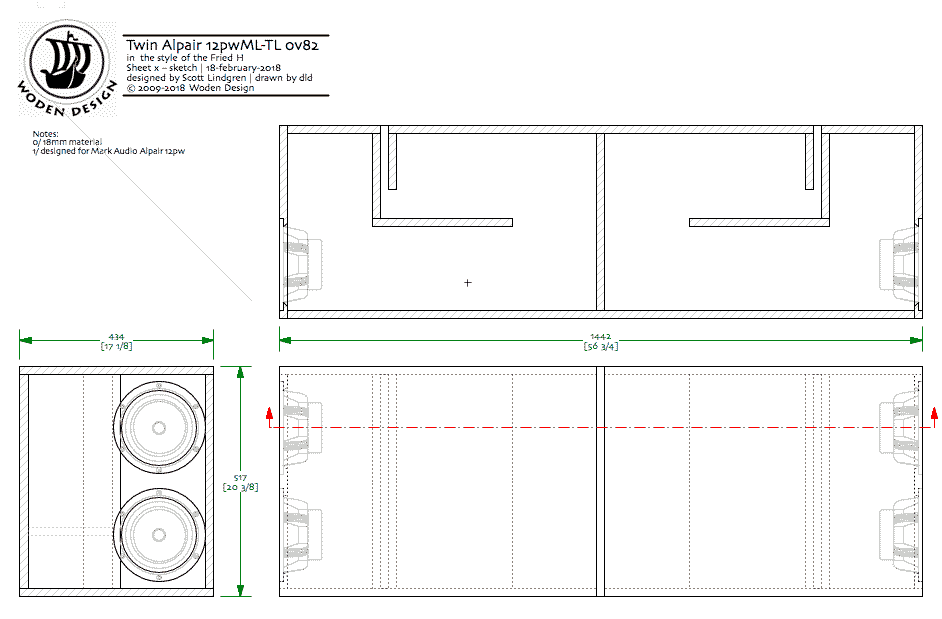
But 4 Alpair 12pw are not cheap...
dave
I have literally a 100+ TLs drawn in my CAD files, most of them ML-TLs. One could likely morph one of those into a shape that could be glued end to end (instead of side-by-side) to create the same kind of shape. If one doesn’t mind terminus at other end, and end-loads the line (not optimum) the construction becomes very easy.
This is for the Alpair12pw (a 6.5” driver) but the same kind of folding could be used for almost any ML-TL… this shape would need to be made wider and shallower, driver put on the top, then turned to the right orientation and another mirror imaged version attached to create the Fried shape. This design could also be doubled to use 2 drivers per side, and not have to make any significant changes. Our MTM with the unfolded version of this ML-TL provides quite satisfactory bass.
http://wodendesign.com/downloads/A12pw-folded-ml-tl-extents.pdf
I quickly sketched out what that would look like:

But 4 Alpair 12pw are not cheap...
dave
another noob question, then: would this design be considered a mass-loaded QWT, with the slot acting as mass, or is it an example of a TQWT?
You are also correct - the price of the Alpair is a bit of a jump, and its full-range nature would be wasted in this application. This sub will be asked to supply bottom-octaves reinforcement to a pair of Jordan JX92Ss.
You are also correct - the price of the Alpair is a bit of a jump, and its full-range nature would be wasted in this application. This sub will be asked to supply bottom-octaves reinforcement to a pair of Jordan JX92Ss.
TQWT is anothr ename for a Voigt pipe and that is the preferred nomenclature (ongoing differences in taper terminology make TQWT confusing). This is a pipe that expands toward the terminus. An ML-TL is usually a straight line (no taper).
The slot at the end is called a restricted terminus, the mass of air in it provides the mass-loading. The ML allows for a shorter line for the same tuning. The terminus also adds more corner to the low pass function of the terminus.
Go looking for ML-TLs until you find one with a driver you like and we can start there.
dave
The slot at the end is called a restricted terminus, the mass of air in it provides the mass-loading. The ML allows for a shorter line for the same tuning. The terminus also adds more corner to the low pass function of the terminus.
Go looking for ML-TLs until you find one with a driver you like and we can start there.
dave
Drivers for Model H
Since you are starting from scratch, and the Model H is for a subwoofer application, I would look for larger drivers than 8 inch. Why should you limited by a prior design?
If you using the coffin style transmission line subwoofer with a version of the Model B, which only used a 4 inch driver for the woofer, I would plan on crossing them over at 200 hz, maybe higher, to keep the lower frequencies out of that tiny woofer.
Retsel
Since you are starting from scratch, and the Model H is for a subwoofer application, I would look for larger drivers than 8 inch. Why should you limited by a prior design?
If you using the coffin style transmission line subwoofer with a version of the Model B, which only used a 4 inch driver for the woofer, I would plan on crossing them over at 200 hz, maybe higher, to keep the lower frequencies out of that tiny woofer.
Retsel
If you can suggest something else, please do so. I'm really open to suggestions.Since you are starting from scratch, and the Model H is for a subwoofer application, I would look for larger drivers than 8 inch. Why should you limited by a prior design?
Current 2.0 system is Jordan JX92s. They don't move enough air to suit the space I'm in. If I can move the bottom octaves out of the Jordans, I hope overall distortion might go down and a bit more visceral experience be had.If you using the coffin style transmission line subwoofer with a version of the Model B, which only used a 4 inch driver for the woofer, I would plan on crossing them over at 200 hz, maybe higher, to keep the lower frequencies out of that tiny woofer.
Speaker driver size
The size of drivers you might need for a Model H depends on a number of factors:
How loud you play your music, movies.
How low in frequency do you want to reach and at what level.
How large is your room and is your room connected to other rooms
How lossy or nonlossy are your room walls which will determine how much bass boost you might expect to achieve
What size box are you willing to tolerate (if you find lower Qts speaker drivers, it would allow you to use a larger speaker driver without requiring a larger box.
If you are going to crossover to your main speakers high enough in frequency, it would be best to have two separate subwoofer boxes instead of one which would allow you to more closely place your subwoofer to your main speakers. Bud Fried designed some of his later transmission line subwoofers to be the speaker stands for his satellite speakers.
The size of drivers you might need for a Model H depends on a number of factors:
How loud you play your music, movies.
How low in frequency do you want to reach and at what level.
How large is your room and is your room connected to other rooms
How lossy or nonlossy are your room walls which will determine how much bass boost you might expect to achieve
What size box are you willing to tolerate (if you find lower Qts speaker drivers, it would allow you to use a larger speaker driver without requiring a larger box.
If you are going to crossover to your main speakers high enough in frequency, it would be best to have two separate subwoofer boxes instead of one which would allow you to more closely place your subwoofer to your main speakers. Bud Fried designed some of his later transmission line subwoofers to be the speaker stands for his satellite speakers.
Well, I don't play music terribly loud and when we watch movies, they're more likely to be RomCom than anything with explosions. The room is about 22x24, one whole wall is glass, carpeted, etc. The Jordans do a fine job on day to day TV and background music, as long as I don't play symphonic music or anything with electronically augmented bass. The room setup won't allow two separate boxes or I could just do something simple like buying two kits from Parts Express. I was drawn to the simplicity of the single module, dual driver setup and thought the Fried dual-TL design could be fairly easy to build.
That said, I didn't realize lower Qts drivers were suitable to TLs. The original Fried's KEF drivers had a Qts of .41, somewhat higher than typical subwoofer drivers that I've seen. I'm still trying to get my head around how to use hornresp, so I'm not great at modeling just yet.
That said, I didn't realize lower Qts drivers were suitable to TLs. The original Fried's KEF drivers had a Qts of .41, somewhat higher than typical subwoofer drivers that I've seen. I'm still trying to get my head around how to use hornresp, so I'm not great at modeling just yet.
I didn't realize lower Qts drivers were suitable to TLs.
You have to do the modelling… but a Q between 0.35 and 0.45 is probably better suited to a simple TL.
zThere are some discussion here on this subject… pkitt IIRC has made some useful posts.
dave
<<snip>>pkitt IIRC has made some useful posts.
I'll search for posts from pkitt. Still trying to learn - drinking from a firehose. Thanks, Dave!
[special=]%[/special]A bit off topic but here is a TL sub I recently designed / built using the Dayton rss265HF driver . Recommended . Thread at Dayton RSS265HF project - Techtalk Speaker Building, Audio, Video Discussion Forum
The neat thing about this design is it digs low but can be crossed over high as well ( think FAST designs )
The neat thing about this design is it digs low but can be crossed over high as well ( think FAST designs )
Attachments
This is actually good for me; while not exactly dropping a driver into a Fried-like enclosure, it certainly has enough promise to have me read the thread! Thank you.[special=]%[/special]A bit off topic but here is a TL sub I recently designed / built using the Dayton rss265HF driver .
...here is a TL sub I recently designed / built using the Dayton rss265HF driver...
That seems a small size… i didn’t see (or maybe check far enuff) to see if it was properly modeled. Two of those could be glued together… might be a little short (or shallow if one moved the driver to the side).
dave
i didn’t see (or maybe check far enuff)
Didn’t look far enuff:
F10, 20 Hz...
dave
A couple of different folks posted plans on that page. Here are mine (stuffed about 70 % of the line length in the HR wizard)
Attachments
Last edited:
- Status
- This old topic is closed. If you want to reopen this topic, contact a moderator using the "Report Post" button.
- Home
- Loudspeakers
- Subwoofers
- Fried H dual TL - what current driver?
